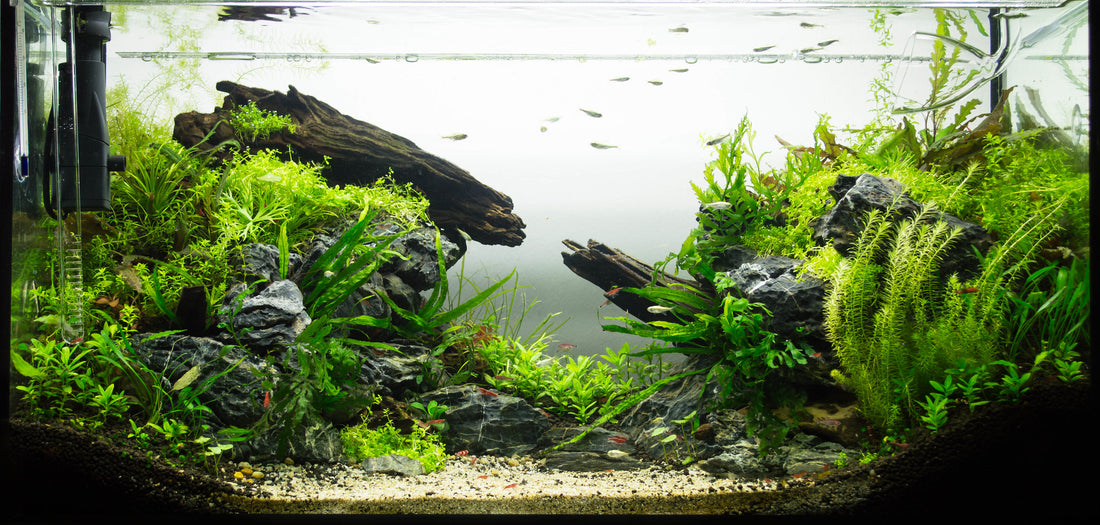
In this blog article, we will guide you through the different types of live aquatic plants, how they differ, what plants work well together for first-time planted tank owners, and how to set up your planted tank for success!

Live aquatic plants are a great addition to any aquarium, as they not only provide aesthetic value but also help promote healthy water conditions and provide a natural habitat for fish and other aquatic animals. They come in different shapes, sizes, and colors, and provide shelter and hiding places for fish, invertebrates, and other aquatic life.
There are three different types of live aquatic plants: tissue culture, emersed grown plants, and submerged grown plants.
Tissue culture plants are grown in a laboratory setting and are free of pests and diseases. They come in small plastic cups with a nutrient gel, and they are an excellent choice for beginners as they are easy to care for and adapt well to a new environment. Emersed plants are grown in a greenhouse setting. These are versatile plants and although well-suited for terrariums or aquariums with high humidity levels, they can be challenging for beginners to cultivate due to their delicate nature. These plants are typically grown in a greenhouse setting with roots in soil and exposed to air, but may require time to adjust and acclimate to new conditions when transplanted to an aquatic environment. It's important to note that some emersed plants may melt or not take well to being moved or uprooted, which can be frustrating for inexperienced hobbyists. Submerged grown plants are grown entirely underwater and are the most common type of live aquatic plants used in aquariums. These plants are an excellent choice for first-time planted tank owners as they are easy to care for and do not require any special setup.

While tissue culture plants are grown in sterile laboratory conditions and are free from algae, pests, and diseases, they tend to be more expensive than emersed/submerged grown plants but offer a greater guarantee of quality and health. Emersed/submerged grown plants, on the other hand, are grown in greenhouses or farms making them more affordable. They are usually larger and more mature than tissue culture plants but may require more maintenance to remove algae and pests.

When choosing plants for your first planted tank, it is essential to select species that will work well together and are easy to care for. For a beginner, it's best to start with a variety of easy-to-grow, low-maintenance plants that can adapt to a wide range of water conditions. Here are five great plants to start with:
- Water Wisteria/Sprite: A fast-growing plant that can thrive in low to high light conditions and absorb excess nutrients.
- Vallisneria: a popular, fast-growing and hardy aquarium plant that can add a beautiful and natural touch to your tank. It can reach up to 24 inches.
- Amazon Sword: A medium-light plant that is easy to care for and can grow up to 20 inches in height.
- Cryptocoryne: A low to medium-light plant that is easy to care for and can tolerate a wide range of water conditions.
- Dwarf Chain Sword: A popular carpeting plant in planted aquariums that can grow up to 10 cm (4 inches) tall.
- Java Fern: A low-light plant that is easy to care for and can be attached to driftwood or rocks.
- Anubias: Another low-light plant that is easy to care for and can be attached to driftwood or rocks.
Although slow-growing, plants like Java Fern and Anubias and some carpeting plants are often recommended for aquascaping due to their slower growth rate and lasting qualities. These plants can be quite challenging for beginners, as they are sensitive to light and nutrient levels and may experience melting if not properly cared for.

To set up your planted tank, start by selecting a suitable substrate for your plants. We recommend using a nutrient-rich substrate like Tropica Soil, which provides essential nutrients to help your plants grow. Next, add hardscape elements like rocks, driftwood, or ceramic ornaments to create an interesting and natural-looking environment for your plants.
When it comes to lighting, use a high-quality LED light with a color temperature of 5000K-7000K, which provides the necessary spectrum of light for your plants to thrive. It's essential to ensure that the light is strong enough to penetrate deep into the water to reach your plants. It is best to keep your lights on a timer each day so that your plants get their daily dose of light to help them grow!
Finally, provide the necessary nutrients for your plants using a high-quality liquid fertilizer like Tropica fertilizer. You can also add CO2 injection to improve plant growth and promote photosynthesis.

To keep your live aquatic plants healthy and vibrant, these tips can make all the difference!
- Trim back overgrown or decaying leaves regularly to promote new growth.
- Check and adjust the lighting and nutrient levels regularly to ensure optimal conditions for photosynthesis.
- Add a quality fertilizer like Tropica to the water regularly to provide essential nutrients to the plants.
- Vacuum the substrate regularly to remove waste and excess nutrients.
- Monitor the water parameters and perform regular water changes (at least 10-20% of the water) to keep the water clean
- If you want to take your planted aquarium to the next level, consider injecting CO2. CO2 can enhance photosynthesis and promote healthy plant growth. Make sure to monitor the CO2 levels to prevent over saturation.
In conclusion, starting your first planted tank can seem daunting, but it doesn't have to be. By selecting easy-to-care-for plants that work well together, using the right substrate, hardscape, lighting, and nutrients, and of course with a little patience and attention, you will be rewarded with a stunning and healthy aquatic environment.
So go ahead and give it a try – your fish will thank you!

